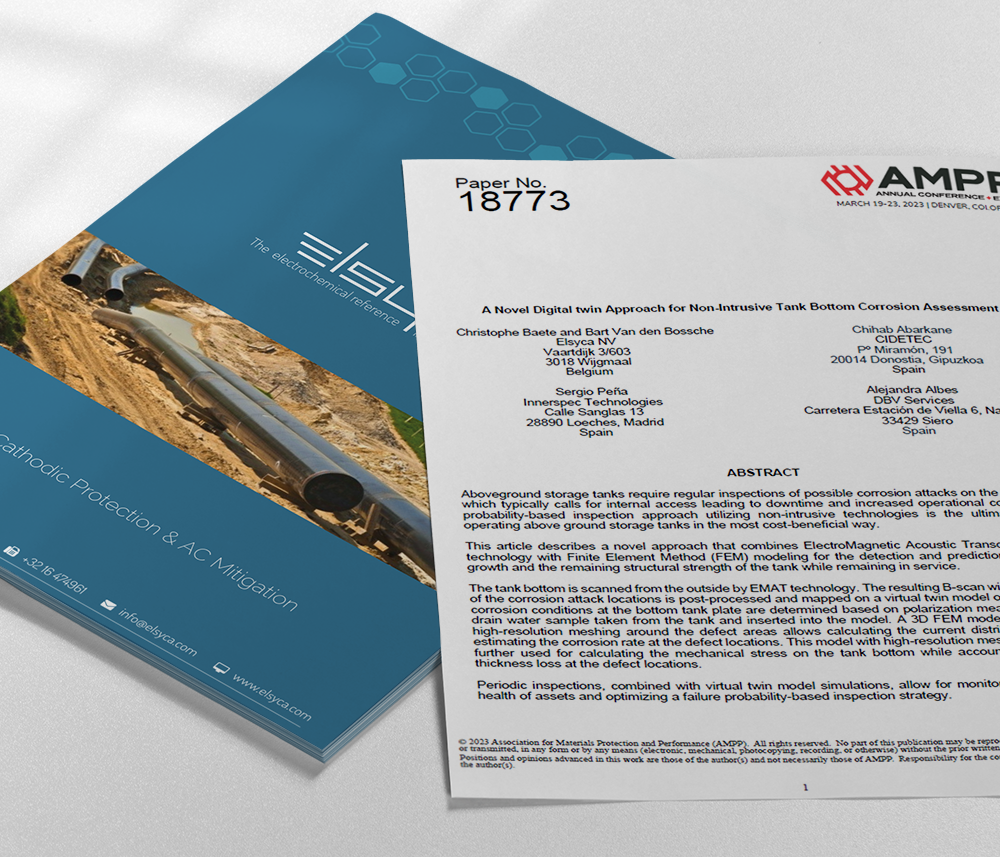
A Novel Digital twin Approach for Non-Intrusive Tank Bottom Corrosion Assessment (AMPP 2023)
AMPP 2023 Conference Paper

A Novel Digital twin Approach for Non-Intrusive Tank Bottom Corrosion Assessment (AMPP 2023)
Christophe Baete and Bart Van den Bossche, Elsyca NV.; Sergio Peña, Innerspec Technologies.; Chihab Abarkane, CIDETEC.; Alejandra Albes, DBV Services.
Paper presented at the AMPP Annual Conference + Expo, Denver, CO, USA, March 2023
Paper Number: AMPP-2023-18773
Abstract
Aboveground storage tanks require regular inspections of possible corrosion attacks on the tank bottom which typically calls for internal access leading to downtime and increased operational cost. A failure probability-based inspection approach utilizing non-intrusive technologies is the ultimate goal for operating above ground storage tanks in the most cost-beneficial way.
This article describes a novel approach that combines ElectroMagnetic Acoustic Transducer (EMAT) technology with Finite Element Method (FEM) modeling for the detection and prediction of corrosion growth and the remaining structural strength of the tank while remaining in service.
The tank bottom is scanned from the outside by EMAT technology. The resulting B-scan with identification of the corrosion attack locations is post-processed and mapped on a virtual twin model of the tank. The corrosion conditions at the bottom tank plate are determined based on polarization measurements in a drain water sample taken from the tank and inserted into the model. A 3D FEM model with intelligent high-resolution meshing around the defect areas allows calculating the current distribution and thus estimating the corrosion rate at the defect locations. This model with high-resolution meshing is then also further used for calculating the mechanical stress on the tank bottom while accounting for the wall thickness loss at the defect locations.
Periodic inspections, combined with virtual twin model simulations, allow for monitoring the structural health of assets and optimizing a failure probability-based inspection strategy.
Introduction
Assessing the corrosion degradation of aboveground tank bottom plates is a critical challenge for the industry. Internal inspections are a useful way of assessing the integrity of assets but might severely impact normal plant operation. In 2006, Chang et al. Error! Reference source not found.] conducted a study on storage tank accidents and concluded that 74% of reported accidents occurred in petrochemical refineries, and 85% of them had caused fire and explosions. Approximately 60% of the accidents are due to cracks, ruptures, and subsequent leakage as a result of corrosion, so health monitoring of the tank is a key factor. Time-based inspection programs are not very cost-efficient, and the industry is evolving towards a Risk Based Inspection (RBI) approach that is rather steered by knowledge of corrosion rate estimates from a combination of a variety of techniques, preferentially non-intrusive in nature.
